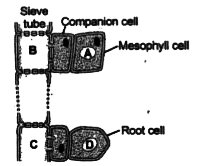Why the transported form of sugar is sucrose ?
Step-by-Step Solution:
1. Photosynthesis in Leaves:
- The process of photosynthesis occurs in the leaves of plants, where glucose is produced as a primary product.
- During this process, sunlight, carbon dioxide, and water are used to synthesize glucose.
2. Conversion to Sucrose:
- After glucose is produced, it is converted into sucrose for transport.
- This conversion is essential because sucrose is more suitable for transport than glucose.
3. Translocation of Sucrose:
- Sucrose is the principal form of carbohydrates that is translocated from the leaves (source) to non-photosynthetic organs like roots (sink).
- The phloem tissue is responsible for the transport of sucrose throughout the plant.
4. Chemical Stability of Sucrose:
- Sucrose is a non-reducing sugar, which means it does not readily participate in chemical reactions that could alter its structure during transport.
- This stability is crucial as it prevents unwanted reactions with other substances in the phloem.
5. Advantages of Using Sucrose:
- The use of sucrose allows for efficient transport without the risk of degradation or reaction with other compounds.
- It also helps in maintaining osmotic balance within the plant cells during the transport process.
Conclusion:
The transported form of sugar in plants is sucrose because it is chemically stable, non-reducing, and suitable for long-distance transport from the leaves to other parts of the plant.
---
- The process of photosynthesis occurs in the leaves of plants, where glucose is produced as a primary product.
- During this process, sunlight, carbon dioxide, and water are used to synthesize glucose.
- After glucose is produced, it is converted into sucrose for transport.
- This conversion is essential because sucrose is more suitable for transport than glucose.
- Sucrose is the principal form of carbohydrates that is translocated from the leaves (source) to non-photosynthetic organs like roots (sink).
- The phloem tissue is responsible for the transport of sucrose throughout the plant.
- Sucrose is a non-reducing sugar, which means it does not readily participate in chemical reactions that could alter its structure during transport.
- This stability is crucial as it prevents unwanted reactions with other substances in the phloem.
- The use of sucrose allows for efficient transport without the risk of degradation or reaction with other compounds.
- It also helps in maintaining osmotic balance within the plant cells during the transport process.
The transported form of sugar in plants is sucrose because it is chemically stable, non-reducing, and suitable for long-distance transport from the leaves to other parts of the plant.
Similar Questions
Knowledge Check
Why sugars are transported in the form of sucrose in phloem ?
AIt is inactive and highly solubleBIt is activeCIt yields high ATPDIt is lighter in weightVein loading is the active transport of sugars from
AMesophyll cells to vesselsBVessels to mesophyll cellsCMesophyll cells to sieve tubesDSieve tubes to mesophyll celllsI. Phloem sap can be transported in any required direction
II. Phloem transports mainly water and sucrose but other sugars, hormones and amino acids are also transported
III. Cytoplasmic strands pass through the holes in the sieve plate forming continuous filaments
IV. Ascent of sap is a pulling movement and translocation of organic solutes is a pushing movementAAll are correctBAll are incorrectCI,II, III are correctDIII and IV are correct
Explain why is transportation of materials necessary in animals ?
View SolutionThe diagram shows the tissues involved in the transport of sucrose in a plant. Where is the highest concentration of sucrose?

View SolutionThe sugar manufactured by plants is transported to other tissues through
View SolutionIdentify the passive part of sugar transport process in plants
View SolutionDuring transport of sugar or amino acid through cell membrane
View Solution
